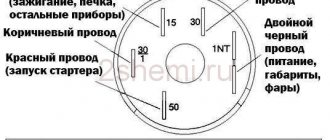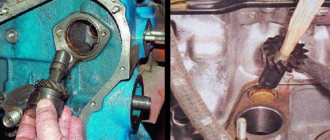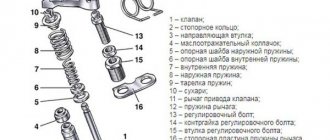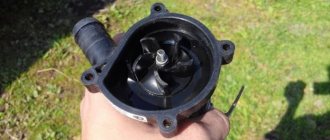Characteristics of motor 2101
For its time, the engine design was advanced; today it allows you to successfully carry out overhauls and tuning on your own in the garage. The manufacturer's plant has created several generations of internal combustion engines, but there have never been any problems with consumables and spare parts.
Prototype engine 124 Fiat
The technical characteristics of the 2101 engine look like this:
| Manufacturer | VAZ |
| Engine brand | VAZ-2101 |
| Years of production | 1970 – 1983 |
| Volume | 1198 cm3 (1.2 l) |
| Power | 47.2 kW (64 hp) |
| Torque | 87.3 Nm (3400 rpm) |
| Weight | 114 kg |
| Compression ratio | 8,5 |
| Nutrition | DAAZ-2101 carburetor (vertical double-row, sequential throttle opening) |
| Motor type | in-line |
| Number of cylinders | 4 |
| Location of the first cylinder | near the timing chain |
| Number of valves on each cylinder | 2 |
| Cylinder head material | aluminum alloy |
| Allowable warpage | manifold gaskets (intake/exhaust) 0.08 mm cylinder head gasket 0.05 mm |
| Valve seat | width 2 – 2.4 mm, angle 45° |
| Camshaft | one upper cylinder head inside, phase width 232°, exhaust valve advance 42°, intake valve lag 40° |
| Camshaft oil seal | diameters – 40 mm, 56 mm, width 7 mm |
| Cylinder block material | cast iron |
| Cylinder diameter | class A – 76 – 76.01 mm class B – 76.01 – 76.02 mm class C – 76.02 – 76.03 mm class D – 76.03 – 76.04 mm class E – 76.04 – 76.05 mm |
| Pistons and rings | piston made of aluminum alloy with tin coating, cast iron rings, compression outside chrome plated (top) and beveled (bottom) |
| Piston diameter | class A – 75.94 – 75.95 mm class C – 75.96 – 75.97 mm class E – 75.98 – 75.99 mm |
| Gaps | piston/cylinder wall – 0.153 – 0.173 mm (standard) or 0.19 mm (maximum) piston rings – 110 mm relative to the cut plane |
| Upper compression ring | 1.535 – 1.555 mm |
| Lower compression ring | 3.957 – 3.977 mm |
| Oil scraper ring | 2.015 – 2.035 mm |
| Gap between piston groove and ring | 0.03 – 0.07 mm |
| Crankshaft | cast iron, casting |
| Number of main bearings | 5 |
| Gearbox neck diameter | 50.795 – 50.775 mm |
| Main journal gap | 0.1 – 0.5 mm |
| Connecting rod bearings | shaft journal diameter – 47.814 mm liner thickness – 1.448 mm liner width – 28.025 – 28.975 mm |
| Crankshaft oil seals | front – diameters 42 mm, 60 mm, width 7 mm rear – diameters 85 mm, 105 mm, width 10 mm |
| Piston stroke | 66 mm |
| Fuel | AI-92 (A-76 allowed) |
| Environmental standards | Euro 2 |
| Fuel consumption | highway – 7.8 l/100 km combined cycle 9.2 l/100 km city – 12 l/100 km |
| Oil consumption | maximum 0.7 l/1000 km |
| Engine oil for 2101 | 5W-30 and 15W-40 |
| Engine oil volume | 3.75 l |
| Replacement frequency | every 5000 km |
| Operating temperature | 80° |
| Motor life | declared 200,000 km actual 500,000 km |
| Adjustment of valves | nuts and feeler gauge |
| Cooling system | forced, antifreeze-A40 |
| Coolant quantity | 9.75 l |
| water pump | polymer impeller, mounted on a block |
| Ignition | coil B117A |
| Candles for 2101 | original – A17-DV, you can install any suitable size with two electrodes |
| Gap between spark plug electrodes | 0.5 – 0.6 mm |
| Valve train chain | double-row roller, 114 links |
| Cylinder operating order | 1-3-4-2 |
| Air filter | dry with replaceable cardboard cartridge and pre-cleaner, temperature adjustment according to the season |
| Oil filter | recommended Mann W914/2 |
| Flywheel | 129 teeth, 0.62 kg internal hole diameter – 25.67 mm outer diameter – 27.75 mm number of mounting holes – 6 pieces no offsets |
| Flywheel mounting bolts | M10x1.25 mm, length 23.5 mm |
| Valve stem seals | Manufacturers Horse or Corteco |
| Compression | pressure in the cylinders from 10 – 14 bar, pressure difference in individual cylinders within 1 bar |
| Oil temperature | 80°С |
| Thermostat temperature | 80 – 84°С |
| Valve pressure inside the radiator cap | 0.7 – 1 bar |
| Content of harmful products in the exhaust | CH <200%, CO <0.5% |
| XX speed | 850 –1000 min-1 |
| Tightening force of threaded connections | spark plug – 37.24 Nm flywheel - 83.3 Nm clutch bolt - 29.4 Nm bearing cap - 80.36 Nm (main) and 50.96 Nm (connecting rod) cylinder head - two stages 39.2 Nm, 112.7 Nm |
The 2101 engine was created for low-octane fuel, so it was usually operated on A-76 gasoline, despite the fact that the manufacturer recommended the use of AI-92 - AI-93 gasoline. Initially, the cylinder diameter was 76 mm, in subsequent modifications it was increased, and again returned to this size more than once.
ICE design
Description
The VAZ-2101 engine first saw the light of day in 1970. The prototype for its creation was the famous FIAT-124 internal combustion engine. But the VAZ-2101 was not a copy of it. There were noticeable differences even in the layout.
For example, the camshaft on the FIAT-124 had a lower location, and on the VAZ-2101 it was located on top of the cylinder head. There were noticeable discrepancies in the size of the cylinder diameters and the piston stroke.
The engine is a carburetor four-cylinder naturally aspirated petrol with a volume of 1.2 liters and a power of 59 hp. s and a torque of 89 Nm.
Installed on Lada cars:
- 2101 (1970-1988);
- 2102 (1971-1986);
- 2103 (1972-1984);
- 2105 (1980-1983).
The cylinder block is cast iron, not lined.
The pistons are aluminum, with three rings, two of which are compression and one is oil scraper. The skirts are covered with tin.
The cylinder head is cast from aluminum. It is attached to the block with 11 bolts. The head cover is metal. The camshaft is made of high-strength cast iron, the cams are hardened to increase strength. There are no hydraulic compensators. The thermal clearance of the valves is adjusted manually.
A double-row roller chain is used as a timing drive.
The power system is standard for that time. Includes carburetor, fuel pump, connecting pipe. Initially, Solex carburetors were used, later they were replaced by more advanced Ozone.
The engine runs confidently on low-octane gasoline. By the way, it was developed for A-76 gasoline.
At the same time, short-term operation on the AI-95 does not cause significant harm to the engine. But in this case, ignition adjustment is necessary.
In general, the VAZ-2101 did not cause much trouble for car owners, but required constant attention.
Design Features
Initially, at the design stage, a feature for the engine was the overhead camshaft:
- The piston stroke decreased by 5.5 mm compared to the Fiat 124 standard;
- the cylinder diameter increased by 3 mm.
This modernization ensured acceleration and rapid acceleration. In addition, the 2101 engine had the following design nuances:
- timing chain transmission;
- unfinished carburetor models;
- major overhaul after 20,000 km.
Valve train chain
Immediately after the release of the first internal combustion engine of this series, the manufacturer AvtoVAZ released a manual in which it indicated which oil to fill in the engine and provided a description of the internal combustion engine parameters to increase the service life of the engines. Thus, the owners of the next three generations of engines had no questions about what oil to pour and in what quantity.
Timing mechanism
Advantages
The engine has very few positive qualities, since it is an early development from domestic manufacturers. But despite this, they are still present in this power unit:
- Simplicity of design. This is the main advantage of the power unit, since it allows you to fix most faults yourself in the garage with minimal knowledge and a set of tools.
- Ability to operate on virtually any type of fuel. A low compression ratio allows a car with such an engine under the hood to run on gasoline with low octane ratings without any problems.
- Low cost of spare parts. Since this is a domestic engine, you can purchase spare parts for it at minimal prices, and their availability will make a large number of modern manufacturers jealous.
Advantages and disadvantages
In the first years of operation, the 2101 engine revealed the following shortcomings:
- noisy operation of the chain drive;
- increased gasoline consumption in the engine due to defects in carburetors;
- frequent ignition adjustments;
- Difficult adjustment of valve clearances.
Solex carburetor
However, a cylinder head improved with a camshaft, an improved intake manifold and an exhaust manifold of the simplest design compensated for these shortcomings. A little later, DAAZ Ozone carburetors were developed, replacing which made it possible to improve the characteristics of internal combustion engine modes.
Carburetor Ozone
Flaws
The power unit was developed on the basis of a prototype FIAT 124 engine, so it was not without its characteristic shortcomings that worried car owners:
- For example, the use of first-generation carburetors led to an increase in fuel consumption. Even in mixed mode, this 1.2 liter engine consumed about 10 liters per 100 kilometers.
- Quite often there were problems with the ignition, which constantly required adjustment.
- Also, during operation, the valve clearances were lost, which led to problems in the operation of the power unit. As a result, it was necessary to carry out complex and time-consuming repairs that involved opening the valve cover.
Maintenance
Considering the design of the internal combustion engine, the manufacturer recommends the following maintenance schedules:
| Maintenance object | Time or mileage (whichever comes first) |
| Valve train chain | replacement after 100,000 km |
| Battery | 1 year/20000 |
| Valve clearance | 2 years/20000 |
| Crankcase ventilation | 2 years/20000 |
| Belts that drive attachments | 2 years/20000 |
| Fuel line and tank cap | 2 years/40000 |
| Motor oil | 1 year/10000 |
| Oil filter | 1 year/10000 |
| Air filter | 1 – 2 years/40000 |
| Fuel filter | 4 years/40000 |
| Heating/Cooling Fittings and Hoses | 2 years/40000 |
| Coolant | 2 years/40000 |
| Oxygen sensor | 100000 |
| Spark plug | 1 – 2 years/20000 |
| Exhaust manifold | 1 year |
With timely cleaning, the lubrication, cooling and fuel supply system operates longer without major repairs.
Positive aspects of the engine
The “penny” has a 4-cylinder in-line engine, the camshaft is located in the upper part. The gas distribution mechanism on the “penny” is driven using a chain. If you don’t tear the engine too much, its service life is about 200 thousand km. It is worth noting that several decades ago, tests were carried out on engines that were installed on cars traveling throughout the Soviet Union. The tests involved cars that drove through deserts, steppes, and in permafrost conditions. Moreover, the motors have traveled more than 200 thousand kilometers. And they have never undergone major repairs. As inspections have shown, they could still serve for a very long time without repair. Their resource turned out to be quite high. At the same time, only the oil recommended by the manufacturer was poured into the VAZ 2101 engine.
Malfunctions: causes, elimination
Unlike motors with a timing belt drive, the 2101 valve bends much less frequently. The main malfunctions of the internal combustion engine are:
| Breaking | Cause | Elimination |
| Blue smoke | rupture of valve seals, bushings and cylinder head gaskets, wear of rings | replacement of consumables and seals |
| Engine overheating | Fan or thermostat failure | replacement of attachments |
| Oil consumption increases | leaks in valve covers, worn out pistons/cylinders | replacing gaskets, installing the next repair size of pistons and rings |
| Knock | crank bearings, connecting rod bearings, increasing valve clearance | replacement of consumables field of qualified diagnostics |
The speed limit of “kopecks” with 2101 engines was 145 km/h, and the car accelerated to “hundreds” in 18–20 seconds in a straight line.
Car VAZ 2101 Kopeyka
Reliability, weaknesses, maintainability
Reliability
According to reviews from car owners, the VAZ-2101 is a fairly reliable engine. The cast-iron cylinder block and the simplicity of the internal combustion engine design made it easy to troubleshoot minor problems. Unpretentiousness to fuel and oil also emphasized the reliability of the engine.
The manufacturer has set the mileage to 125 thousand km. In practice it is significantly exceeded. With normal engine care, a mileage of 250-300 thousand km without major repairs is not the limit.
Of course, there are many problem areas in the engine (more on this later). But, firstly, most of them are provoked by motorists themselves, and secondly, timely and high-quality engine maintenance completely reduces their negativity to a minimum or completely eliminates it.
Numerous reviews from car owners about the engine also emphasize its reliability. For example, Vovikas from Irkutsk writes: “...the engine runs smoothly, starts with half a turn, drives quickly...”. Alexey from Sarapul draws attention to the excellent engine start in severe frosts: “...confident start at -20֯, good at -30֯...”.
There are fewer negative reviews, but they exist. As already mentioned, many problems arise due to the fault of motorists themselves. Vasily from Syktyvkar confirms: “... the engine spun up to 8000 on the third... the inlet valve was slightly bent in the 4th pot...”.
Comments, as they say, are unnecessary. If someone thinks that a “penny” with its own engine is a car, then it is useless to convince such a driver otherwise.
Proper operation and maintenance make the VAZ-2101 practically indestructible.
Weak spots
It can be stated that there are no pronounced weak points on the engine. Almost all engine problems occur with the help of the car owner.
Inability to start the engine. There are many reasons for this phenomenon. The main ones are malfunctions in the ignition system, fuel pump and carburetor.
Timely elimination of detected problems, timely maintenance and refueling with high-quality gasoline significantly reduce the possibility of starting problems.
Motor overheating. Usually occurs due to a faulty thermostat, dirty cooling system components, or a malfunctioning water pump. Constant monitoring of the coolant temperature eliminates the dangerous consequences of engine overheating.
Unstable operation of the internal combustion engine at idle speed, tripping. Most often, the reason lies in a clogged carburetor.
The problem can be caused by a malfunction in the ignition system (faulty spark plug, unsatisfactory condition of the contacts in the switch-distributor, breakdown of the insulation of high-voltage wires).
Decrease in unit power. Here the problem must be looked for in the fuel pump, carburetor, increased contact gap of the breaker, erroneous ignition timing, misaligned valves. Wear of the CPG also does not contribute to an increase in engine power.
Conclusion: there are weaknesses in the engine, but their negative impact directly depends on the car owner’s attitude towards the engine.
Maintainability
VAZ-2101 is highly maintainable. Car owners note that this engine takes several laps. This is facilitated by the simplicity of the engine design and the cast-iron cylinder block, which can be bored repeatedly.
The engine can easily be repaired on its own in a garage. The availability of spare parts and their low cost coupled with the absence of complex adjustments make the restoration process accessible to almost every car enthusiast.
When selecting parts and assemblies for repair, you need to pay attention to their authenticity. Nowadays, when purchasing, it is very easy to run into an outright fake, and if you use it, you will have to do all the work again.
We are not talking about purchasing a contract engine, since finding a decent copy is quite problematic.
Analogue spare parts are also in short supply. But there is a good opportunity to select the necessary components with slightly modified configurations. Such a replacement can have a positive effect on improving the technical and operational performance of the motor.
For example, replacing a native contact breaker with an electronic (contactless) one improves fuel economy and increases the power of the internal combustion engine.
Thus, there is no doubt about the maintainability of the VAZ-2101.
Tuning
- The tuning option with an increase in volume involves boring the cylinders and replacing the pistons with spare parts from older VAZ engines. Such work is somewhat difficult and can be expensive. It is necessary to bore the cylinders, replace the pistons and crankshaft. It is often easier to carry out an engine swap by installing an engine from a VAZ five or six.
- Installing a turbine can be considered solely in theory, since this tuning option leads to rapid failure of the VAZ 2101, the engine tuning of which was performed using a turbine and compressor. An engine with an installed turbine has a service life of about 20 thousand kilometers, while the power indicator in rare cases exceeds the 100 horsepower mark. This option is used only for cars participating in drag racing, where car owners do not care about the life of the car, but only the technical characteristics of the forced engine are at the forefront.
FAQ
Fuel consumption - city 9.4l. | track 6.9l. | mixed 9.2l/100 km
Oil consumption - 700 g. per 1000 km
VAZ 2101 engine weight - 114kg
Overall dimensions of the VAZ 2101 engine (LxWxH), mm - 540x522x621
What kind of oil to pour into the VAZ 2101 engine: 5W-30 5W-40 10W-40 15W-40
How much oil is in engine 2101: 3.75 l.
When replacing, fill in about 3.5 liters.
Service life of VAZ 2101: 1. According to the plant – 125 thousand km 2. In practice – 200 thousand km
Source











